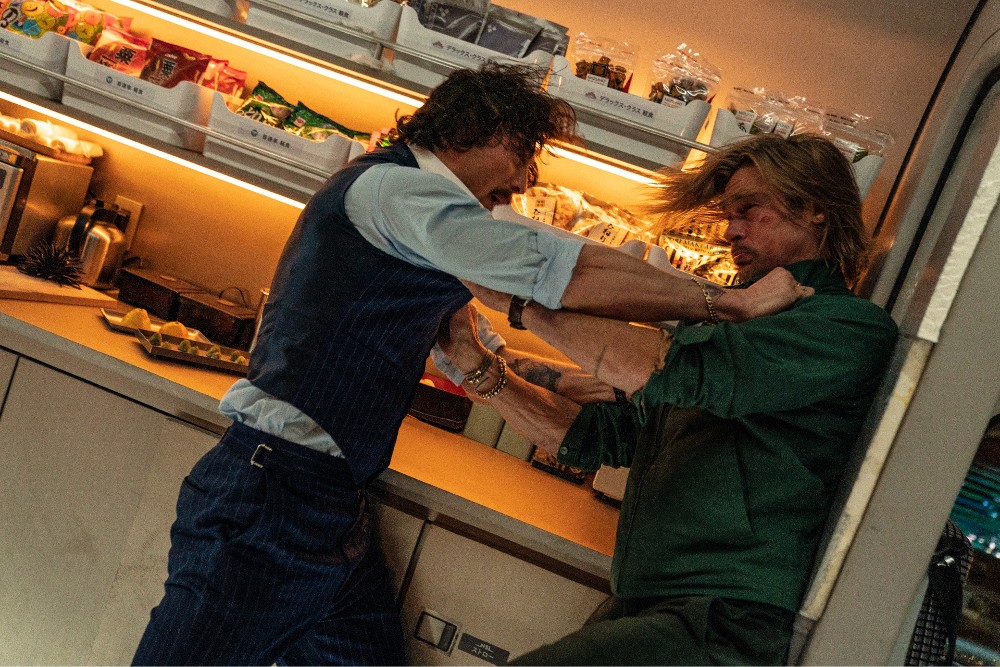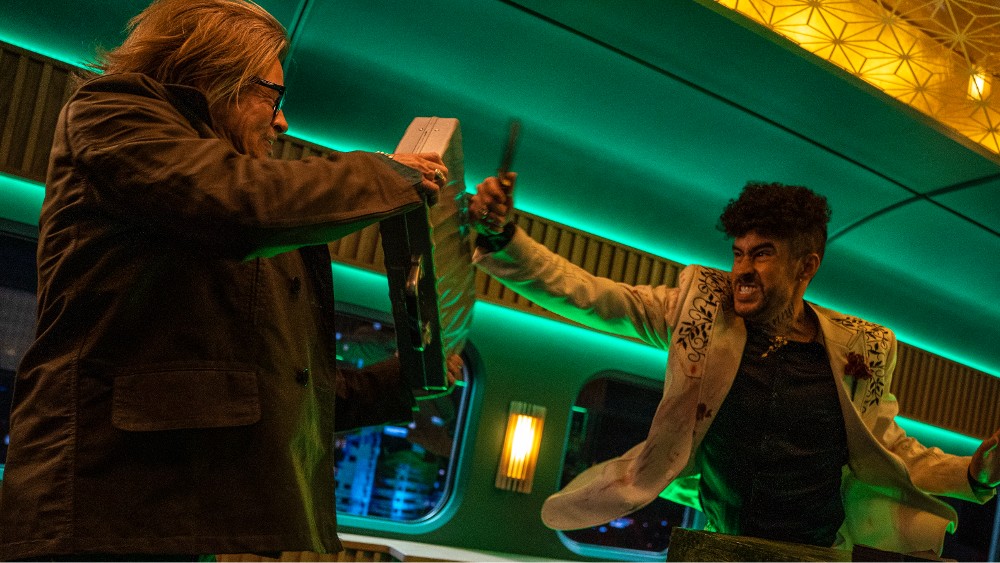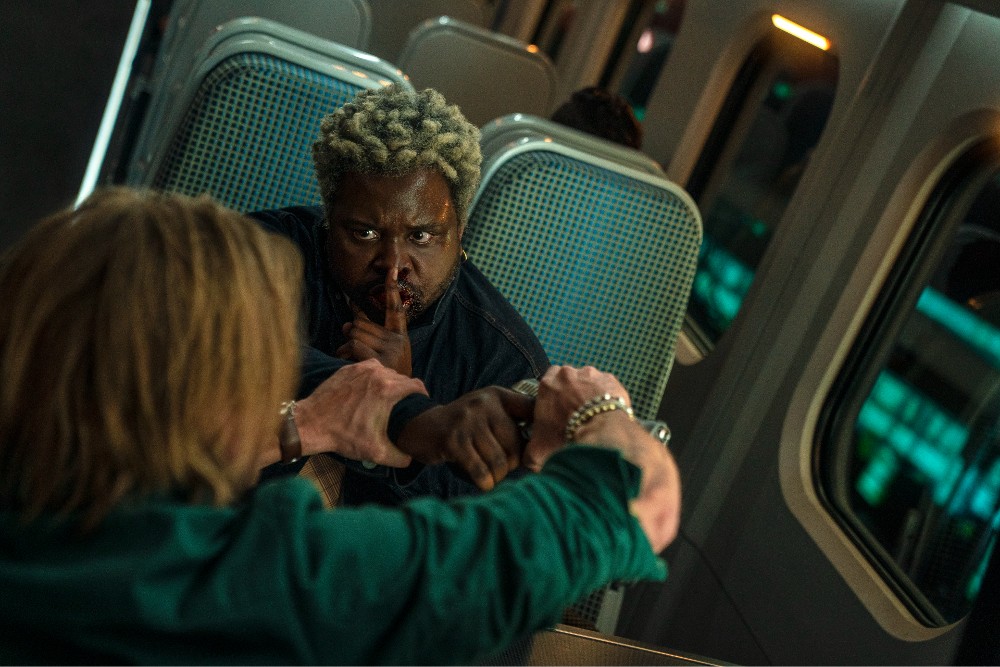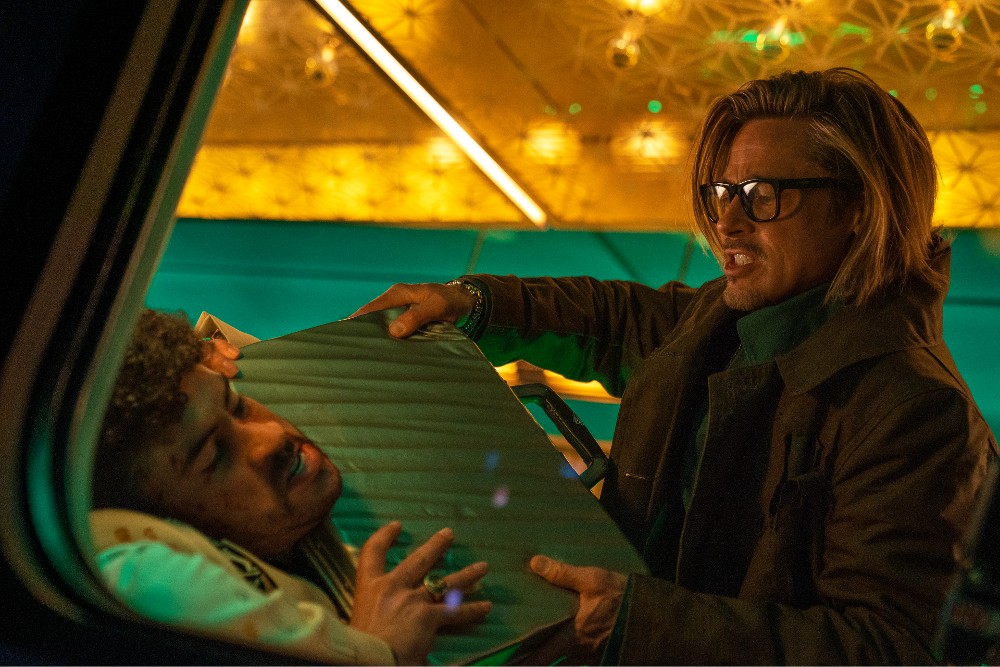
David Leitch’s Bullet Train pulled into theaters this past weekend, pitting Brad Pitt against a cadre of assassins played by Aaron Taylor-Johnson, Brian Tyree Henry, Joey King, and Bad Bunny, among others, all while riding a fast-moving train through Japan.
As has become the norm with Leitch’s films, which include the first John Wick, Deadpool 2, and Atomic Blonde, the action plays an incredibly important role. Leitch knows the importance of a great stunt team, having served as Pitt’s stunt double in both Fight Club and Troy before embarking on his own directing career.
For Bullet Train, Leitch once again worked with Stunt Coordinator and 2nd Unit Director Greg Rementer, who has been working in stunts for almost a decade. Some of his notable work includes performing similar roles on last year’s Nobody, starring Bob Odenkirk; the Paramount+ family movie Secret Headquarters (now streaming); and the upcoming DC movie Black Adam starring Dwayne Johnson.
Below the Line spoke with Rementer over the phone last week, and he shared how he and his stunt team pulled off some of the amazing fight sequences, all within a confined space.

Below the Line: You’ve done some amazing work over the years, and I think stunt people deserve a lot more respect both inside and outside the industry. Hollywood is catching up, but I think that it’s crucial that moviegoers understand the importance of what you do.
Greg Rementer: I really appreciate that. Thank you. We’re doing our best to shed some light on [the fact] that we are changing and growing as contributors to Hollywood, more as action designers, and combining our knowledge and skill of designing and shooting and telling great stories with action, too. It is a process, but I love it, so no matter what, I’m not in it for the accolades, [and] I’m just happy to be a part of it.
BTL: You’ve been working with David Leitch since Atomic Blonde and generally just worked your way up the stunt ladder, so how did you first connect with him and join his stunt team?
Rementer: I originally connected with David on Atomic Blonde in the largest capacity that I have worked with him. However, I’ve known David through the industry for many years. When he was directing second unit, and I was focusing more on performing, I worked with him on movies like Escape Plan and Jurassic World. I always envied and really appreciated what they did, and how they brought life to action, and the path that they wanted.
As time went on, I actually came across a great friend and mentor of mine named Sam Hargrave, who is now also directing, through his path of stunt-coordinating and second unit directing. I became one of his guys on his team, doubling, shooting stunt vis, helping to choreograph for him, and assistant coordinating.
Sam eventually began directing, and Sam was the second unit/stunt coordinator on Atomic Blonde, so he brought me on there and worked more closely with David, and when Sam got his opportunity to direct his first movie [with] Extraction, that left a hole with David, so he moved up and I moved up. It kind of hasn’t stopped since then, so right place, right time, I guess.
BTL: I love hearing stories about people moving up the ranks of stunts. Is hand-to-hand combat or close combat more or less your specialty?
Rementer: I would 100 percent say that [with] my eyes closed, I could do combat choreography in general. That is definitely my specialty. [I did] martial arts my whole life [and watched] Jackie Chan movies on repeat. You name it, martial arts, I want to learn it. I’m obsessed with it, how to find fun, new, inventive ways to put hand-to-hand stuff in films.
That being said, as a stunt person, you have to be well-rounded. Am I the best at what I do when it comes to designing hand-to-hand stuff? I like to say that’s my specialty, sure, but what I like to do when I’m coordinating or directing [is], if there’s something that I’m not strongest in, I bring in the best people. If I want to do some amazing car stuff that I can dream up, I call the Red Bull Team. I call the best in the business, and I say, ‘Do you want to be a part of this? Do you want to help me get in there and drive these cars? How do we bring it to life?’
I think that’s where some people fall astray. We have such great resources in our community and outside of our community. All you have to do is look outwards, sometimes, and trust the best. That’s why I was fortunate to work with Sam and Dave, because they trusted me. I love what they do, whether it’s fire, we’ll have a car on wires, or underwater to make what I think could be great, even better, through teamwork.

BTL: I like that you do stunt coordinating and second unit. A lot of the Hong Kong guys know where to put the cameras so they won’t be destroyed during a stunt, but also, so they won’t potentially injure their team.
Rementer: Absolutely. If you think about it, when you’ve come up from someone on-camera to behind [the] camera, if you’ve ridden that wire, or if you’ve thrown that punch a million times, you can always anticipate exactly where it’s gonna go. Let’s say I put a guy on a wire and want to flip ’em and lay ’em on the ground, I can guesstimate that I can put the camera within an inch of his landing point, keep that performer safe and get a great shot.
That’s 100 percent why I love what I can do, too, because I can find creative ways to put the camera in place, based on my experiences. I totally agree with you, from legends such as Wu Ping, all the way through The Matrix, like Chad Stahelski and David Leitch, journeyman stunt performers who made their way into designing and directing.
BTL: That brings me to my next question. You work with a lot of dramatic actors like Bob Odenkirk in Nobody, and James McAvoy and Charlize Theron in Atomic Blonde, so how do you work with actors to get them where they need to be if action isn’t normally in their wheelhouse?
Rementer: There’s a formula that we use, what I like to call, “Stunt boot camp” or “Stunt training camp,” or just “training” in general. What we like to do is build a vocabulary of physical movement for your entire body. Instead of spending all day teaching one fight and learning that fight choreography, we teach all of our cast how to do all the moves that your body would need to do — every punch on both sides, every kick, every knee. How to twist your hips, how to bend your knees, how to move and fight, how to circularly and linearly move, and when they all have mastered the basics, then we can make any fight choreography we want.
I’ll say, ‘Okay, now remember how you learned to throw that right punch and that left hook? Now, just do that,’ and they realize they can do it, without even thinking about it. We take everyone individually through that boot camp. Whether it was Brad, who is a seasoned, veteran athlete [and] screen-fighting phenomenon, or Brian, who this may have been his first opportunity. Everybody gets an equal [chance] to learn the way we do it, especially when we’re working with David.
BTL: Is this the most hand-to-hand combat Brad’s been involved with in quite some time?
Rementer: Aside from Fight Club, maybe Troy, if we were to count it, and maybe Mr. or Mrs. Smith, but that was a little more gun-oriented. [In Bullet Train], Brad fights Bad Bunny, he fights Brian, he fights Aaron, he fights Zazie [Beetz], he fights goons — you might be right. Certainly, at least the highest number of lead cast members that he’s fought, that’s for sure.
BTL: Working with the actors, is part of it making sure they’re in proper shape to be able to do what they need to do? I know Zack Snyder used to have his actors go through an intensive Gym Jones training camp, and he’d do the entire regimen along with them. Is that part of your job, or do the actors just need to be conscious that they need to be in proper shape to make this kind of movie?
Rementer: We try to make sure that we tailor what we’re going to do towards the action that they’re gonna be presented. I wouldn’t say that we get them with weights, necessarily. Of course, we always recommend physical fitness to keep themselves in shape, but part of that training that we do through our fight choreography is, there’s physical training hidden in there.
If we do two hours a couple [of] times a week, we’re starting with a half-hour warm-up, everything from the basics of jumping jacks to burpees to push-ups, then we have a whole regime of hip twisting, punching drills. We’ll get boxing gloves on. We get ’em sweating, and we’re doing drills hidden in the exercises that are getting them prepared better for the choreography.
They might think that they’re only learning choreography, but really, we’re getting them in shape, we’re training them, we’re preparing them for take after take after take of fight choreography. I wouldn’t say that we phrase it in a way that’s “Alright, now it’s time to train.” We build it in.

BTL: Doing so much close space fighting, does that mean that every wall on the physical train had to be able to come off to do what you need to do? I’m talking to production designer David Scheunemann, so how did you work with him to make sure the environment worked for what you needed to do?
Rementer: The good news is with working with David Leitch, he works with Jonathan Sela, the DP, David Scheunemann, the production designer, all the time, so we have this really fantastic rapport of the team that’s always with us, [including] Paul Berry, our First AD. So it’s an open door policy. We walk in or he walks into us and goes, ‘David was saying maybe we should use this as a breakaway or maybe we want to put some bullet holes in the ceiling or maybe we need to take that wall out. Maybe this window needs to be plexiglass when I slam his face on it, so it doesn’t break.’
David Scheunemann is an absolutely incredible person to work with. He never loses the aesthetic but always understands that what we need for stunts needs to be flexible as well, so we have options for when David wants to riff on a different idea. We broke a lot of his train, so, fortunately, between him, set dec, [and] special effects, everybody put their heads together about how we were going to keep such a tight space fresh by taking out walls and breaking walls, busting seats, and cutting them in half. Early on, it’s really just, ‘I think we’re gonna do a lot of this, and I think we need 20 extra chairs in first-class.’ That’s just a part of the process. The whole team is super-collaborative in that aspect, so [we were] very fortunate.
BTL: Is it tough to come up with new action moments for each movie? How do you keep things feeling fresh?
Rementer: I live, eat, sleep, and breathe this stuff. I feel like a famous poet has a notebook of poetry you’ll never read. I have catalogs of crazy stuff that I’ve seen along the way that I’ve adapted or come up with, that may or may not ever be seen. Even just on a movie like Bullet Train with David, we strive to give options, because it gives him choices to be inspired for different things. We have terabytes of stunt previs that will never even make the movie, just there to inspire.
I always go back to my roots. I love Jackie Chan, I can watch Jackie Chan all day, and I’ll always see something new that I didn’t catch when I saw any of his other stuff that inspires me, or [that] I want to pay homage to or replicate or do differently. Is it hard to keep it fresh? Of course, but that’s our job, and it’s our passion. Because it’s both those things, there’s no shortage of it, especially ’cause all you gotta do is go on Instagram, and there are millions of things out there that just make you go, ‘Oh, my gosh, look at that guy do this. What if we do this?’
I can’t say it enough. I’ve got the best stunt team in the world, between the guys who have been with me in the last couple of movies that David also trusts, my wire-rigging team that I say, ‘I want to do this thing with bodies flying all over the place,’ and we work together to make it come true. So it’s a collaborative team effort, but we love it.
BTL: Have you seen Everything Everything All at Once yet?
Rementer: I love it. So great.
BTL: That’s a good example, because those two guys had uploaded some of their stunts to YouTube, and that got them the gig to stunt coordinate the movie.
Rementer: Yeah, exactly. How can I express what I think that movie is? It’s like [a] Donnie Yen [movie] meets Kung Fu Hustle, it was just really fun, really inventive. I know that team. The choreography team on that movie, Martial Club, Brian and Andy Le. Brian actually plays a part in the “17 Kills” sequence in Bullet Train. He gets beaten up quite a bit in that movie. They’re spectacular, those guys. If you get a chance to see their content, whether it’s on Instagram or YouTube, they’re called Martial Club. They are so incredible, and so true to Hong Kong martial arts action cinema. They were the best team for a movie like that because it was so fun in [that]Hong Kong style.
BTL: I know you also worked with the Russos, and that you’ve done a lot of stunt doubling for motion capture. Do you ever end up fighting yourself in those movies, where you’re stunt doubling two different characters?
Rementer: I did. In fact, in the finale of Infinity War, I did the motion capture for Thanos, as he did what we called “The Long Walk” as he was taking out the Avengers before he makes it to Vision. I was actually physically doubling Bucky in the scene where Thanos knocks him away, so I always laugh that I killed myself in that movie.

BTL: I’m not sure if you’ve seen their new movie, The Gray Man, but there’s a lot of interesting discourse online where people compliment the action you did in Bullet Train as a positive while comparing it negatively to the action in Gray Man, which I don’t agree with. When you watch action movies you didn’t work on, do you end up critiquing how they did the action, or are you able to turn that part of your brain off?
Rementer: I’m a huge fan of turning my brain off. I say that because I love movies. When I go in, I like to be immersed. I don’t want to try to figure it out; I don’t want to be spoiled. I want to enjoy the ride. Even Bullet Train. When I finally saw the finished product, I put everything aside, I’ve got some popcorn, and I lean forward, and I laughed, and it was great. And I got teary-eyed with moments, and I got soaked into the score. I just love movies. I love going to movies. I’ve built a movie theater in my house for myself, because it’s just what I love, it’s my passion.
That being said, when I watch movies that have a lot of action, I see it differently than I would if I wasn’t, but I appreciate it because I understand the complications, the intricacies, the loopholes, and a movie like Gray Man is beautiful. Those action set pieces were great. The characters, like Chris Evans plays a bad guy with a mustache. It was brilliant. I love it. He’s a great bad guy. Ryan Gosling is the Gray Man. Not to say that to plug David Leitch‘s next movie, The Fall Guy [starring Gosling], but I think that people that bad mouth or compare… there’s no need to compare. The Gray Man was The Gray Man, and Bullet Train is Bullet Train. Bullet Train kicks ass, and Gray Man kicks ass. You have to immerse yourself and enjoy that ride.
What I loved about movies like John Wick — and I say that because David was the co-director on that — [is that they] set a trend for the way we shoot and look at action. Now, people use that as a staple. It’s simple [and] effective, you trained your actors really well, you put the cameras back, and you watch two people do some cool shit. I saw that in Gray Man, [and] you see that in Bullet Train. I appreciate that, not to mention dreaming up these spectacular set action set pieces with these incredible new camera moves. I thought they did a great job.
I think Bullet Train is a signature genre movie for David, and it’s beautiful, and it’s fun, and it’s just everything to me. It’s so important when it comes to designing action that the action doesn’t start and stop when the dialogue starts and stops. It’s one movie. I gotta say, relative to everything else, I’m really proud of everything that we did and got to do with David and my team for Bullet Train because I think it kicks ass, so I’m really proud of it and everybody that was involved.
BTL: I know you also did stunts/2nd unit on Secret Headquarters. I spoke to the film’s directors and they mentioned you were a “great camp counselor” for the kids. What are some of the added concerns when doing action with kids? Kids are pretty resilient, but you have to be extra careful, I’d imagine.
Rementer: Of course. When it comes to stunts, it’s safety first. We design action with excitement and danger in mind, and then when we come to practical application, it’s “safety first,” whether it’s kids or adults. I’ve worked with kids before. Yes, there’s an extra layer of protection and safety all around, because they gotta go to school, and their parents are there, but I treat kids and adults alike in that safety [comes] first. We teach them the same kind of physical movement, and we give everybody the same opportunity to say, ‘If this is something you want to try and we think it’s safe, you can do it. If it works for you, we’ll try that.’
I love the challenge. I thought it was so great about Bullet Train, not to change the subject back to that, but fighting in a train, how do you keep it fresh? You’re just in one train car for the whole movie, so what do you do? How do you make it fun? You make one a quiet car, you make one a Momomon car. Going back to your original question prior to this, it’s all about keeping it fresh, having fun, and being safe. If you can do that and push the action to hold the story and move the characters along, then we’re doing our jobs.
BTL: Thanks so much for taking the time to chat. I always love shining a spotlight on the amazing stunt people on movies, because they absolutely deserve it
Rementer: It really means a lot to everyone in my industry, so we greatly appreciate it. Thank you so much.
Bullet Train is now playing in theaters nationwide. Look for Below the Line’s interview with the film’s Production Designer very soon, as well as an interview with Secret Headquarters directors Ariel Schulman and Henry Joost.





